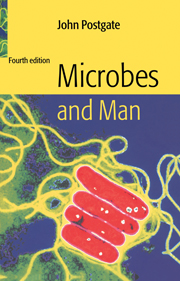Book contents
- Frontmatter
- Contents
- Illustrations
- Preface
- 1 Man and microbes
- 2 Microbiology
- 3 Microbes in society
- 4 Interlude: how to handle microbes
- 5 Microbes in nutrition
- 6 Microbes in production
- 7 Deterioration, decay and pollution
- 8 Disposal and cleaning-up
- 9 Second interlude: microbiologists and man
- 10 Microbes in evolution
- 11 Microbes in the future
- Further reading
- Glossary
- Index
5 - Microbes in nutrition
Published online by Cambridge University Press: 18 December 2009
- Frontmatter
- Contents
- Illustrations
- Preface
- 1 Man and microbes
- 2 Microbiology
- 3 Microbes in society
- 4 Interlude: how to handle microbes
- 5 Microbes in nutrition
- 6 Microbes in production
- 7 Deterioration, decay and pollution
- 8 Disposal and cleaning-up
- 9 Second interlude: microbiologists and man
- 10 Microbes in evolution
- 11 Microbes in the future
- Further reading
- Glossary
- Index
Summary
I imagine that few people are unaware that beers, wines, cheeses and so on are prepared by allowing microbes to act on foodstuffs; even fewer can have failed to recognize that food goes bad through the action of microbes. But these two kinds of microbial activity are relatively minor aspects of the importance of microbes in the whole field of human and animal nutrition. In this chapter I shall naturally deal with food preparation; its spoilage will crop up in Chapter 7. But I shall start with a topic which is quite different, yet which is perhaps the most important stage in nutrition: the assimilation of food.
Assimilation, technically speaking, is the process that follows digestion. Once food is eaten, digestion starts, and enzymes of the mouth, stomach and intestines break the food down into chemical fragments which the organism can absorb into its blood stream and use for its biochemical purposes. Carbohydrates are broken down to sugars, proteins to amino-acids, fats are partly broken down, partly emulsified. Some components of food – woody matter, for instance – are not readily broken down by the digestive enzymes, and it is here that microbes come in. Ruminant mammals, such as sheep or cattle, have a primary stomach (called the rumen) in which grass, which is almost the only food they eat, quietly ferments. The rumen is a sort of continuous culture of anaerobic microbes, including protozoa and bacteria, which collectively ferment the starch and cellulose of grass to yield fatty acids, methane and CO2.
- Type
- Chapter
- Information
- Microbes and Man , pp. 133 - 170Publisher: Cambridge University PressPrint publication year: 2000



